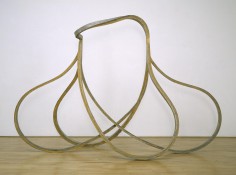RICHARD DEACON
理查德•迪肯
ריצ’רד דיקון
リチャード·ディーコン
РИЧАРД ДИКОН

source: tateorguk
Richard Deacon was born in Bangor, Wales, in 1949. He studied at Somerset College of Art, Taunton (1968), St Martin’s School of Art, London (1970–3) and the Royal College of Art (1974–7) where he gained an MA in Environmental Media. He has exhibited widely throughout the world with solo exhibitions, and in significant international surveys such as documenta IX (1992) and Venice Biennale (2007). Deacon’s work is also permanently sited in locations around the world ranging from Yonge Square Plaza in Toronto, to Redheugh Bridge in Gateshead, from Krefeld in Germany to Auckland, New Zealand. He was awarded the Turner Prize in 1987 and he has recently unveiled new public commissions for the Cornice of St. James’s Gateway, Piccadilly and the Kunstmuseum Winterthur, Switzerland (both 2013). He lives and works in London.
.
.
.
.
.
.
.
source: tateorguk
The organic curves of Deacon’s sculpture were inspired by parts of the human body. The title is taken from the Biblical phrase ‘He that hath ears to hear let him hear’ and relates to Deacon’s interest in the way eyes, ears and mouths channel our perceptions of the world. The sculpture also resembles forms found in nature, echoing the shape of a hilly landscape. The oozing resin and rings in the wood are reminders that this material was itself once alive, and part of nature.
.
.
.
.
.
.
.
source: tateorguk
Welsh sculptor. In 1980 he began making a series of sheet metal and laminated wood sculptures in simple organic shapes, their surfaces congruent with their structure. Deacon considered himself a fabricator rather than a constructor and used unformed basic material to make sculptures that explored, by the use of metaphor, ideas that defined human experience through language and the senses. Although the forms devised by Deacon were fundamentally abstract in appearance, this metaphorical reference to the body and its methods of gathering information was alluded to in idiomatic titles such as The Eye Has It (1984; London, ACGB; see England, fig. 34). As Deacon widened both his vocabulary and his range of materials, incorporating, for instance, vinyl and plywood into Boys and Girls (1982; London, British Council), so he increased the depth and complexity of metaphor into a highly flexible personal idiom.
.
.
.
.
.
.
.
source: baike
理查德·迪肯(Richard Deacon) (1984年获“透纳奖”提名,1987年获得“透纳奖”) 生于1949年,威尔士雕塑家。1980年,他开始创作一系列金属和木头薄板的简单机体形状,表面与结构相一致。迪肯认为他自己是一个制作者,而不是一个建造者,他利用未经加工成型的基本材料制作雕塑,通过比喻的方法来探索语言和感觉决定的人类体验。虽然迪肯创造的形状从表面看来是抽象的,但是他却通过富有含义的命名来体现作品对身体的比喻和收集信息的方法,例如《亲眼所见(The Eye Has It)》”(1984,伦敦,ACGB;见于England, fig. 34)。迪肯不断拓宽他的语言表达和选取材料的范围,例如,在“《男孩和女孩(Boys and Girls)》”(1982,伦敦,英国文化协会)中加入了乙烯树脂和层压木板。他由此创造了更深刻更复杂的比喻含义,形成了极为灵活多变的个人风格。
.
.
.
.
.
.
.
source: sculptureorg
Richard Deacon prefers to call himself a fabricator. Several aspects of Deacon’s self-perception as a sculptor, as well as his conception of the place and role of sculpture, are wrapped up in this label. He says, “Material and its manipulation are core areas in what I do. ‘Matter’ and ‘stuff’ are the words I tend to use.” Whereas a sculptor like Antony Gormley represents the stuff and matter of the body as a point-of-entry to and signifier of transcendence, Deacon’s practice and his language always return to the material, to the work of fabrication.
.
.
.
.
.
.
.
source: scaithebathhouse
リチャード・ディーコン
彫刻作品の制作を通して80年代以降のイギリス彫刻の興隆を決定づけた<ニュー・スカルプチュア>の流れに大きく貢献することになったディーコンは、85年にはロンドンのテート・ギャラリーにて個展を開き、87年にはターナー賞を受賞、イギリスを代表するアーティストとしての評価を決定的なものにしました。近年の活動は展示スペースでの展覧会にとどまらず、彫刻作品と建築物との関連性を追求した規模の大きい作品から、パブリックな場所での作品展示など多岐にわたっています。緻密な計算と構造に支えられたパワーある彫刻を追求する一方、自由に流れるような有機的な造形もディーコンの作品の特徴であり、また、作品の規模も小さなもものはテーブルに載る小品から、大きなものは建築物と対峙する巨大なものまで、その多岐にわたる創作の力には目を見張るものがあります。金属や木材を中心に、皮やビニールなど多彩な素材を用いる手法もディーコンの作品の可能性を大きく広げています。
日本初となる今回の個展では、異なる素材による新作2点を含む彫刻作品4点と、写真をベースにした素描を展示します。

